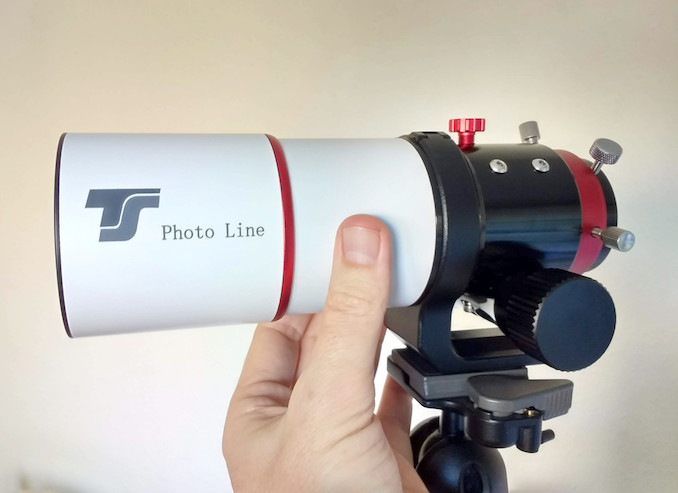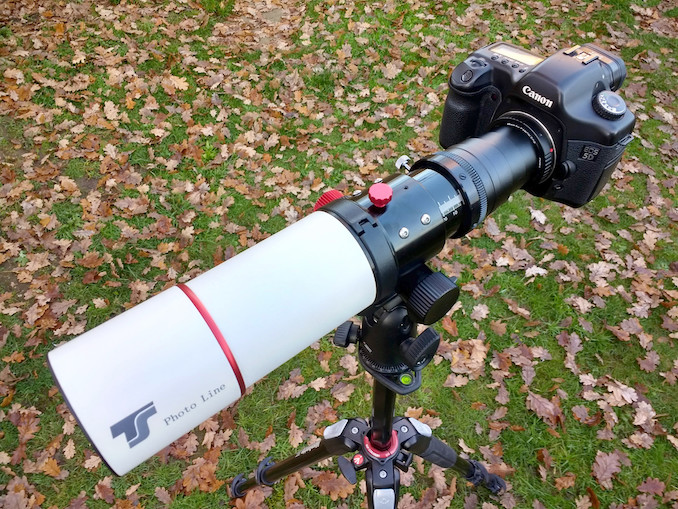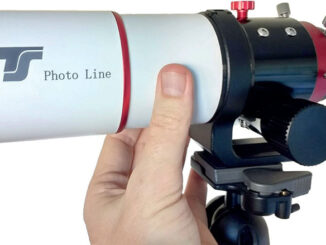
I built my first telescope out of a 100mm diameter, two-element government surplus lens of 500mm focal length in the early 1970s. While I was immensely proud of my four-inch, f/5 refractor, its images of the Moon and bright planets were surrounded by a vivid purple halo. Thus I had my introduction to the bane of simple lens-based instruments: chromatic aberration. I quickly learned that a simple compound lens composed of a sandwich of two types of glass with opposing dispersive (prismatic colour-making) qualities only goes a limited way to cancelling out this annoying inherent defect of refractors.
In fact, the use of crown and flint types of glass to fashion a so-called ‘achromatic’ lens capable of bringing two wavelengths of the colour spectrum (usually red and blue) to focus dates back to the British inventor Chester Moore Hall, in around 1730. However, for an achromat of typically encountered sizes to have an acceptable level of colour correction, an optician needs to make the instrument’s focal length at least twelve times the diameter (or aperture) of the lens, which immediately explains the long tubes of classical refractors.

In the intervening years, opticians have developed so-called ‘apochromatic’ (or ‘apo’) refractors, typically composed of a three-glass element sandwich capable of bringing three colours of the visible spectrum (typically red, green and blue) to a common focus. Such exquisitely crafted instruments from high-end manufacturers such as Takahashi and Astro-Physics use exotic glasses, ground and polished to complex geometries, to create compact refractors that provide essentially perfect imagery for visual and photographic use, but they usually command an eye-watering price.
However, comparatively recent optical research has led to the mass production of extra-low-dispersion (‘ED’) glass types capable of curbing the tendency of a lens to split white light into a spectrum to such an extent that short focal-ratio refractors with excellent colour correction can now be produced from a two-element lens, sometimes referred to as a doublet. Calcium fluoride (CaF2), which occurs naturally as the mineral fluorite, makes a superior ED lens element, but it is a somewhat fragile material to grind and polish, plus it’s thermally unstable (meaning that it’s shape changes slightly with temperature).
An ED glass manufactured by Ohara in Japan, known as S-FPL-53 (commonly written FPL53), has very similar optical characteristics to fluorite, but it is less expensive, far easier to polish and is more stable, both chemically and thermally. Ohara also produces S-FPL-51, which is an ED glass that is cheaper than FPL53 and even easier to work with. With the correct prescription of lens geometry and mating glass element, FPL51 is capable of producing an excellent ED refractor, but the choice of FPL53 glass wherever possible gives the optical designer far greater freedom to produce a doublet with a performance deserving of the name ‘apo’. Such is the on-paper prescription of the TS-Optics PhotoLine 60mm, f/6 FPL53 that I review here.
First impressions
When a 17 × 21 × 31 centimetre shipping box arrived at my door from Telescope-Service (TS) in Germany, I initially thought that I’d been sent the wrong product: could a package this small really contain a 60mm, f/6 refractor? It turns out that it can, for once it’s divested of packaging, the instrument is just 23 centimetres long from the front lens cap to the rear of its 2-to-1.25-inch eyepiece adapter when both its dewshield and focuser drawtube are fully retracted.
Being so small, the TS PhotoLine 60mm, f/6 forgoes tube rings and a dovetail bar in favour of a reversible, hinged split-ring collar with an L-shaped foot possessing two ¼–20 and one central 3/8ths-inch photo-tripod connections. Straight out of the box, the instrument tips the scales at just 1.52 kilograms.

The objective, which has a full aperture of 60mm, is fully multi-coated with the unblemished deep green hue that one comes to expect of a quality lens these days. The rear collar of the sliding dewshield, fine focusing knob, two-inch eyepiece-locking collar at the end of the focuser and the drawtube lock knob are all anodised in a striking red that contrasts with the otherwise wholly black and white livery. (For the more conservative among you, TS-Optics provide a version of this instrument in a black and white finish with a gold-coloured fine focus knob.)
Inside the optical tube, which has an effective matte black coating, there is a single baffle about two centimetres behind the doublet. The remaining suppression of scattered internal light is provided by the 14.2 centimetre-long focuser drawtube that has an internal diameter of 50.8mm (two inches) and a finely milled finish with a matte black coating, a combination that is particularly effective. The 118mm-long helically-cut brass rack has no discernible backlash against the pinion, and one full rotation of the 1:9:3 ratio fine focusing wheel advances the drawtube 2.25mm over a total travel of 75mm.
The drawtube’s engraved millimetre scale is useful for reproducing approximate visual and photographic foci (more on imaging later). The focuser doesn’t rotate with respect to the tube, but should the focusing knobs not lie in a convenient position for you, then slackening a knurled knob on the hinged split-ring collar enables you to rotate the entire optical tube relative to the L-shaped foot. The drawtube is lockable once precise focus is found. Two-inch push-fit diagonals and accessories are secured by a non-marring brass compression ring via three clamping bolts at 120-degree intervals.

While the machining and finish of the tube, lens cell and focuser are all first rate and the instrument feels reassuringly robust in hand, I have a few niggles with the design. The end of the extended dewshield lies just 50mm in front of the objective, which is barely adequate. Given that there is still 50mm of tube behind the retracted dewshield, why not make it 50mm longer to ensure a full 100mm of dew protection and an effective light shield for daytime use?
I think that Telescope-Service also missed an opportunity to make the L-shaped mounting foot’s cross-section compatible with the Vixen-style dovetail block used on the vast majority of small telescope mounts; TS expects you to purchase a Vixen-compatible dovetail rail for an extra €24.89. Furthermore, while there are two domed-head Allen mounting bolts on either side of the focuser, a finderscope mounting shoe is a €24 add-on. I appreciate that margins are tight these days, but a Vixen dovetail mounting rail and a finderscope mounting shoe should be standard equipment for a telescope of this calibre.
Visual impressions
Since the PhotoLine 60mm, f/6 has a drawtube focusing range of 75mm, then just about every two- and 1.25-inch (50.8 and 31.75mm) push-fit star diagonal and eyepiece combination should permit you to reach focus at infinity – every eyepiece at my disposal compatible with this instrument certainly did. Given the focal length of 360mm and the focal ratio, mature observers with fully dilated pupils of around 5mm would be advised not to use eyepieces with a focal length longer than 30mm if they wish to accommodate the full exit pupil. At the magnification of 12× delivered by such an eyepiece, even 1.25-inch oculars will deliver true fields of view well in excess of four degrees; two-inch eyepieces will give you fields in excess of six degrees for monocular-like views.
At the upper magnification range, one should be mindful that this is just a 60mm aperture telescope, so eyepieces with focal lengths shorter than about 3mm (or the Barlowed equivalent) are to be avoided. For my high-power tests I used a 3.2mm focal length TMB Optical Planetary II eyepiece delivering 113× magnification in conjunction with a TeleVue 1.25-inch mirror diagonal. Used in this configuration during the daytime, tiny yet intense specular reflections viewed in distant beads of dew revealed that the review instrument was perfectly collimated with a vanishingly small amount of under-correction.
Defocusing the instrument a few waves intra-focally revealed symmetrical diffraction rings with a faint purple tinge, while the diffraction rings viewed the same distance extra-focally displayed a central reddish hue and greenish-blue periphery. However, at focus, even on extremely bright examples of water droplet ‘artificial stars’ in sunlight, the colour correction of the review model TS PhotoLine 60mm, f/6 was undoubtedly impressive.
For those observers intending to also use the instrument as a daytime spotter-scope for nature study or sporting events, I could focus on subjects just 7.5 metres away while using the TeleVue 1.25-inch diagonal and a 10mm Plössl eyepiece at 36×. However, for regular terrestrial use, an Amici prism star diagonal for delivering a fully erect image, plus a quality zoom eyepiece, would be good investments.

Turned to the night-time sky, the TS-Optics PhotoLine 60mm, f/6 FPL53 apo excels at lunar observations. On an evening of moderately good seeing at the end of civil twilight on Monday 2 December, the six-day-old waxing lunar crescent presented a wealth of detail in the 3.2mm TMB eyepiece at 113× magnification. My observing notes relate that in the Moon’s northern polar region, the horn-shaped crescent tapered to a jagged point with three nearby high lunar peaks beyond the terminator catching the rays of sunlight, looking like tiny islands in a jet-black sea separated from an isthmus of land.
Heading south along the sunrise line on the lunar surface, 95-kilometre-wide impact crater Posidonius, on the north-eastern edge of Mare Serenitatis, was replete in detail, in particular showing the almost semi-circular concentric rim of the inner lava-flooded crater, as well as the central craterlet Posidonius A and hints of the main crater’s extensive rille system. In Mare Serenitatis itself, wrinkle ridges parallel to its eastern shore were similarly well seen. Further south, 40-kilometre-wide Plinius prominently marked the boundary of Mare Tranquillitatis and I lingered a while on the southern edge of this lunar sea, near the famous landing site of Apollo 11.
The highlight of this particular lunar excursion was the prominent and similarly sized trio of craters Theophilus, Cyrillus and Catharina, to the west of Mare Nectaris in the Moon’s southern hemisphere. One-hundred-kilometre-wide Theophilus intrudes into Cyrillus, the former clearly displaying its massive, terraced rim and central triple peak. Something that I had probably noticed before at this waxing lunar phase but not really appreciated was the hourglass-like ‘waist’ separating craters Cyrillus and Catharina that was wreathed in shadow on the night of 2 December. At magnifications ranging from 33× to 113×, I placed the lunar crescent just outside the edge of the field of view and couldn’t detect any spurious glows from scattered light in any orientation.
Photographic impressions
Given its relatively short f/6 focal ratio, this instrument will show signs of field curvature with both cropped and full-frame DSLRs, or large-format CCD/CMOS devices. This is not a fault of the TS PhotoLine 60mm f/6 FPL-53 apo per se, since all fast refractors without some form of field-flattening accessory will display stars as short streaks in the corners of the frame, while those stars in the centre of view are perfectly round and sharp.
Fortunately, Telescope-Service supplies an optional flattener and field corrector known as the TSFlat60. Just 95mm long and adding 237 grams to the mass of the telescope, the TSFlat60 has a male M54×0.75 thread on the telescope side that screws securely into the focuser’s drawtube once the two-inch eyepiece locking collar is unthreaded. On the camera side of the TSFlat60 there’s a standard male M48×0.75 photo thread, so all you need is the T-mount bayonet adaptor appropriate for your DSLR camera body to automatically establish the optimal back focus of 55mm from the male M48 thread.

The optics of the TSFlat60 are fully multi-coated like the telescope’s objective lens, while all inside surfaces of the field flattener are milled and coated matte black to prevent internal reflections. Given that there is no provision for rotating the telescope’s focuser for framing a shot, the TSFlat60 neatly incorporates a robust 360-degree rotation collar secured by a single knurled lock knob. Another feature of the field flattener is that it’s designed to preserve the f/6 focal ratio (and 360mm focal length) of the TS-Optics PhotoLine 60mm f/6 FPL-53 apo.
Furthermore, the TSFlat60 is also designed to deliver a fully corrected and illuminated field of view that is 41mm wide, hence cameras with full-frame sensors (43.25mm diagonal) are almost fully covered. In tests with my full-frame Canon 5D Classic, aggressive image processing revealed negligible vignetting, while plate solving revealed a true field of view of 5.54 × 3.69 degrees and a scale of 4.57 arcseconds per pixel. Given that the Canon 5D Mark 1 has 8.2 micron pixels, a combination of the TS PhotoLine 60mm, f/6 FPL-53 apo plus the TSFlat60 plus a DSLR delivers a true focal length of 370mm, hence the TSFlat60 is really a 1.03× field flattener. However, the field was indeed flat, albeit with negligible pincushion distortion.

Conclusions
The TS PhotoLine 60mm, f/6 FPL-53 apo arrives on the market amid some stiff competition from the suspiciously similar Astro-Tech AT60ED, the Altair 60EDF and the William Optics Zenithstar 61 apo (the Zenithstar’s 61mm, f/5.9 specification likely results from a lens cell with a slightly larger entrance pupil). It’s worth noting that the Altair 60EDF also includes as standard the 360-degree rotation collar supplied with the TSFlat60 but at a similar price, which is a big plus in the Altair’s favour. All of these telescopes are a perfect match for camera tracking mounts such as the Sky-Watcher Star Adventurer or iOptron SkyGuider Pro.
However, the fact that one has to buy a Vixen-style dovetail bar and a finderscope mounting shoe in order to fully exploit these instruments for serious astronomical imaging almost suggests that celestial imaging is of secondary importance to the manufacturers – or it could just be that margins are so tight that these items are considered extras. Whichever way you look at it, there’s no denying that the TS PhotoLine 60mm, f/6 apo is a cheaper alternative to certain prime camera lenses, and its marriage of well-figured FPL53 and lanthanum glass ensures it delivers a notable photo-visual performance, both on land and in the sky.
Specifications:
Telescope:
Optical design: FPL53 and lanthanum air-spaced doublet refractor
Coating: multi-coated on all air-to-glass surfaces
Aperture: 60mm
Focal length: 360mm
Focal ratio: f/6
Resolution: 1.9 arcseconds
Weight: 1.52kg
Tube length: 230mm (retracted)/355mm (extended)
Focuser: two-inch rack-and-pinion focuser with 1:9:3 reduction gearing
Drawtube travel: 75mm
Manufacturer/Supplier: teleskop-express.de
Price: €449
Flattener and field corrector:
Overall length: 95mm
Weight: 237g
Illuminated and corrected image field: 41mm
Image scale: 1.03×
Connection at telescope side: M54 × 0.75 thread (male)
Connection at camera side: M48 × 0.75 thread (male), length 4mm
Working distance: 55mm from the male M48 thread
Manufacturer/Supplier: teleskop-express.de
Price: €165



